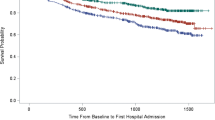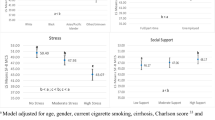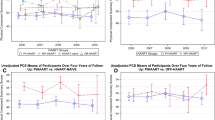Abstract
Objectives
Determine the relative impact of chronic hepatitis C (CHC) and co-morbid illnesses on health-related quality of life (HRQoL) in 3023 randomly selected veterans with known hepatitis C virus antibody (anti-HCV) status who previously completed a veteran-specific HRQoL questionnaire (SF-36V).
Methods
Multiple regression analyses were performed to measure the relative contribution of anti-HCV status, four demographic variables, and ten common medical and six psychiatric co-morbidities to HRQoL between 303 anti-HCV(+) and 2720 anti-HCV(−) patients.
Results
Anti-HCV(+) veterans were younger, reported a lower HRQoL on seven of eight 36-Item Short Form Health Survey for Veterans (SF-36V) subscales (P ≤ 0.001) and the mental component summary (MCS) scale (P < 0.001). The ten medical and six psychiatric co-morbidities had variable impact on predicting lower HRQoL in both groups. After adjusting for demographic variables and co-morbid illnesses, we found that anti-HCV(+) patients reported a significantly lower MCS score (P < 0.001) and a trend toward a lower physical component summary (PCS) score (P < 0.07) compared to anti-HCV(−) veterans. Among the anti-HCV(+) veterans, co-morbid medical illnesses contributed to impaired PCS but not to MCS.
Conclusions
Veterans with CHC were younger than HCV(−) veterans and hence less likely to have other co-morbid medical illnesses. Medical co-morbidities seen in those veterans with CHC contribute to impaired PCS but not MCS. Anti-HCV(+) status negatively affects HRQoL, particularly MCS, independently of medical and psychiatric co-morbidities.
Similar content being viewed by others
Abbreviations
- Anti-HCV:
-
Antibody to hepatitis C virus
- CHC:
-
Chronic hepatitis C
- COPD:
-
Chronic obstructive pulmonary disease
- EIA:
-
Enzyme-linked immunoassay
- HCV:
-
Hepatitis C virus
- HRQoL:
-
Health-related quality of life
- ICD-9:
-
Ninth version of the Clinical Modification of the International Classification of Diseases
- IRT:
-
Item response theory
- MCS:
-
Mental component summary
- PCS:
-
Physical component summary
- PTSD:
-
Posttraumatic stress disorder
- RP:
-
Relative precision
- SF-36:
-
36-Item Short Form Health Survey
- SF-36V:
-
36-Item Short Form Health Survey for Veterans
- VAPAHCS:
-
VA Palo Alto Health Care System
- VHA:
-
Veterans Health Affairs
- VISN:
-
Veterans Integrated Service Network
References
Armstrong, G. L., Wasley, A., Simard, E. P., McQuillan, G. M., Kuhnert, W. L., & Alter M. J. (2006). The prevalence of hepatitis C virus infection in the United States, 1999 through 2002. Annals of Internal Medicine, 144, 705–714.
Alter, M. J., Mast, E. E., Moyer, L. A, & Margolis, H. S. (1998). Hepatitis C. Infectious Disease Clinics of North America, 12, 13–26.
Foster, G. R., Goldin, R. D., & Thomas, H. C. (1998). Chronic hepatitis C virus infection causes a significant reduction in quality of life in the absence of cirrhosis. Hepatology, 27, 209–212.
Davis, G. L., Balart, L. A., Schiff, E. R., et al. (1994). Assessing health-related quality of life in chronic hepatitis C using the sickness impact profile. Clinical Therapeutics, 16, 334–343 (discussion 271–272).
Ware, J. E., Jr., Bayliss, M. S., Mannocchia, M., et al. (1999). Health-related quality of life in chronic hepatitis C: impact of disease and treatment response. The interventional therapy group. Hepatology, 30, 550–555.
Bonkovsky, H. L., & Woolley, J. M. (1999). Reduction of health-related quality of life in chronic hepatitis C and improvement with interferon therapy.The Consensus Interferon Study Group. Hepatology, 29, 264–270.
Fontana, R. J., Moyer, C. A., Sonnad, S., et al. (2001). Comorbidities and quality of life in patients with interferon-refractory chronic hepatitis C. The American Journal of Gastroenterology, 96, 170–178.
Chong, C. A., Gulamhussein, A., Heathcote, E. J., et al. (2003). Health-state utilities and quality of life in hepatitis C patients. The American Journal of Gastroenterology, 98, 630–638.
Miller , E. R., Hiller, J. E., & Shaw, D. R. (2001). Quality of life in HCV-infection: Lack of association with ALT levels. Australian and New Zealand Journal of Public Health, 25, 355–361.
Schwarzinger, M., Dewedar, S., Rekacewicz, C., et al. (2004). Chronic hepatitis C virus infection: Does it really impact health-related quality of life? A study in rural Egypt. Hepatology, 40, 1434–1441.
Obhrai, J., Hall, Y., & Anand, B. S. (2001). Assessment of fatigue and psychologic disturbances in patients with hepatitis C virus infection. Journal of Clinical Gastroenterology, 32, 413–417.
Yates, W. R., & Gleason, O. (1998). Hepatitis C and depression. Depress Anxiety, 7, 188–193.
Lim, J. K., Cronkite, R., Goldstein, M. K., & Cheung, R. C. (2006). The impact of chronic hepatitis C and comorbid psychiatric illnesses on health-related quality of life. Journal of Clinical Gastroenterology, 40, 528–534.
Hussain, K. B., Fontana, R. J., Moyer, C. A., Su, G. L., Sneed-Pee, N., & Lok, A. S. (2001). Comorbid illness is an important determinant of health-related quality of life in patients with chronic hepatitis C. The American Journal of Gastroenterology, 96, 2737–2744.
Desai, R. A., Rosenheck, R. A., & Agnello, V. (2003). Prevalence of Hepatitis C virus infection in a sample of homeless veterans. Social Psychiatry and Psychiatric Epidemiology, 38, 396–401.
Roselle, G. A., Danko, L. H., Kralovic, S. M., Simbartl, L. A., & Kizer, K. W. (2002). National hepatitis C surveillance day in the Veterans health administration of the department of Veterans affairs. Military Medicine, 167, 756–759.
Cheung, R. C. (2000). Epidemiology of hepatitis C virus infection in American veterans. The American Journal of Gastroenterology, 95, 740–747.
Kizer, K.W. (2000). Re-engineering the Veterans health care system. In P. Ramsaroop, M. Ball, D. Beaulieuu, et al. (Eds.). Advancing federal sector health care (pp. 79–96). New York: Springer Verlag.
Randall, M., Kilpatrick, K. E., Pendergast, J. F., Jones, K. R., & Vogel, W. B. (1987). Differences in patient characteristics between Veterans Administration and community hospitals. Implications for VA planning. Medical Care, 25, 1099–1104.
Moore, D., Feurer, I., Speroff, T., et al. (2003). Survival and quality of life after organ transplantation in veterans and nonveterans. American Journal of Surgery, 186, 476–480.
Kazis, L. E., Miller, D. R., Clark, J., et al. (1998). Health-related quality of life in patients served by the Department of Veterans Affairs: Results from the Veterans Health Study. Archives of Internal Medicine, 158, 626–632.
Gilsen, R., Hoeymans, N., Schellevis, F. G., et al. (2001). Causes and consequences of comorbidity : A review. Journal of Clinical Epidemiology, 54, 661–674.
Fortin, M., Lapointe, L., Hudon, C., et al. (2004) Multimorbidity and quality of life in primary care : A systemic review. Health and quality of life outcomes, 2, 51.
Selim, A. J., Berlowitz, D. R., Fincke, G., et al. (2004). The health status of elderly veteran enrollees in the Veterans Health Administration. Journal of the American Geriatrics Society, 52, 1271–1276.
Kazis , L. E. (2000). The Veterans SF36 health status questionnaire: development and application in the Veterans Health Administration. Medical Outcomes Trust Monitor, 5, 1–2.
Ware, J. E., Jr., & Sherbourne, C. D. (1992). The MOS 36-item short-form health survey (SF-36). I. Conceptual framework and item selection. Medical Care, 30, 473–483.
Ware, J. E., Kosinsky, M., & Keller, S. D. (1994). Physical and mental health summary scales: A users manual. Nosto, MA: The Health Institute, New England Medical Center.
Kazis, L. E., Skinner, K., Rogers, W., et al. (1998). Health status and outcomes of veterans: physical and mental component summary scores (SF-36V). National Survey of Ambulatory Care Patients, Mid-year Executive Report. Washington D.C.: Department of Veteran Affairs, Veterans Health Administration, Office of Quality and Performance.
Chow, G. C (1960) Tests of Equality Between Sets of Coefficients in Two Linear Regressions. Econometrica, 28, 591–605.
Olson, S. H., Iyer, S., Scott, J., et al. (2005). Cancer history and other personal factors affect quality of life in patients with hepatitis C. Health and Quality of Life Outcomes, 3, 39.
Rodger, A. J., Jolley, D., Thompson, S. C., Lanigan, A., & Crofts, N. (1999) The impact of diagnosis of hepatitis C virus on quality of life. Hepatology, 30, 1299–1301.
Zacks, S., Beavers, K., Theodore, D., et al. (2006). Social stigmatization and hepatitis C virus infection. Journal of Clinical Gastroenterology, 40, 220–224.
Briggs, M. E., Baker, C., Hall, R., et al. (2001). Prevalence and risk factors for hepatitis C virus infection at an urban Veterans Administration medical center. Hepatology, 34, 1200–1205.
el-Serag, H. B., Kunik, M., Richardson, P., & Rabeneck, L. (2002). Psychiatric disorders among veterans with hepatitis C infection. Gastroenterology, 123, 476–482.
McHorney , C. A., Haley, S. M., & Ware, J. E. (1997). Evaluation of the MOS SF-36 Physical Functioning Scale (PF-10): II. Comparison of relative precision using Likert and Rasch scoring methods. Journal of Clinical Epidemiology, 50, 451–461.
Hobart , J. C., Cano, S. J., Zajicek J. P., & Thompson, A. J. (2007). Rating scales as outcome measures for clinical trials in neurology: Problems, solutions, and recommendations. Lancet Neurology, 6, 1094–1105.
Raczek, A. E., Ware, J. E., Bjorner, J. B., Gandek, B., et al. (1998) Comparison of Rasch and summated rating scales constructed from SF-36 physical functioning items in seven countries: Results from the IQOLA Project. International Quality of Life Assessment. Journal of Clinical Epidemiology, 51, 1203–1214.
Ware, J. E., Bjorner, J., & Kosinski, M. (2000) Practical implications of item response theory and computerized adaptive testing: A brief summary of ongoing studies of widely used headache impact scales. Medical Care, 38[Suppl 9], II73–II82.
Wolinsky, F. D., Coe, R. M., Mosely, R. R., 2nd, et al. (1985). Veterans’ and nonveterans’ use of health services. A comparative analysis. Medical Care, 23, 1358–1371.
von Wagner, M., Lee, J. H., Kronenberger, B., Friedl, R., Sarrazin, C., et al. (2006). Impaired health-related quality of life in patients with chronic hepatitis C and persistently normal aminotransferase levels. Journal of Viral Hepatitis, 13, 828–834.
Butt, A. A., Justice, A. C., Skanderson, M., Rigsby, M. O., Good, C. B., & Kwoh, C. K. (2007). Rate and predictors of treatment prescription for hepatitis C. Gut, 56, 385–389.
Acknowledgements
This study is supported by Department of Veterans Affairs Health Services Research and Development Service research funds and VA grant LIP 62–096. Views expressed are those of the authors and not necessarily those of the Department of Veterans Affairs.
Author information
Authors and Affiliations
Corresponding author
Additional information
J. W. Kwan and R. C. Cronkite have contributed equally to the study.
Rights and permissions
About this article
Cite this article
Kwan, J.W., Cronkite, R.C., Yiu, A. et al. The impact of chronic hepatitis C and co-morbid illnesses on health-related quality of life. Qual Life Res 17, 715–724 (2008). https://doi.org/10.1007/s11136-008-9344-3
Received:
Accepted:
Published:
Issue Date:
DOI: https://doi.org/10.1007/s11136-008-9344-3




